Peoria, IL Pollen and Allergy Report for Summer 2023
Pollen Allergy Trends in Peoria, IL
When is pollen lowest in Peoria, IL?

March
Lowest month total PPM
Avg. PPM
When is pollen highest in Peoria, IL?

April
Highest month total PPM
Avg. PPM
How does pollen in Peoria, IL compare to Illinois?
Peoria has a lower average PPM than the state of Illinois.
Peoria yearly avg PPM:
Illinois yearly avg PPM:
How does pollen in Peoria, IL compare to the USA?
Peoria has a higher average PPM than the USA.
Peoria yearly avg PPM:
USA yearly avg PPM:
Is pollen worse this year in Peoria, IL?
Spring 2023 was worse than spring 2022.
Spring 2023 PPM:
Spring 2022 PPM:
Average PPM in Peoria, IL
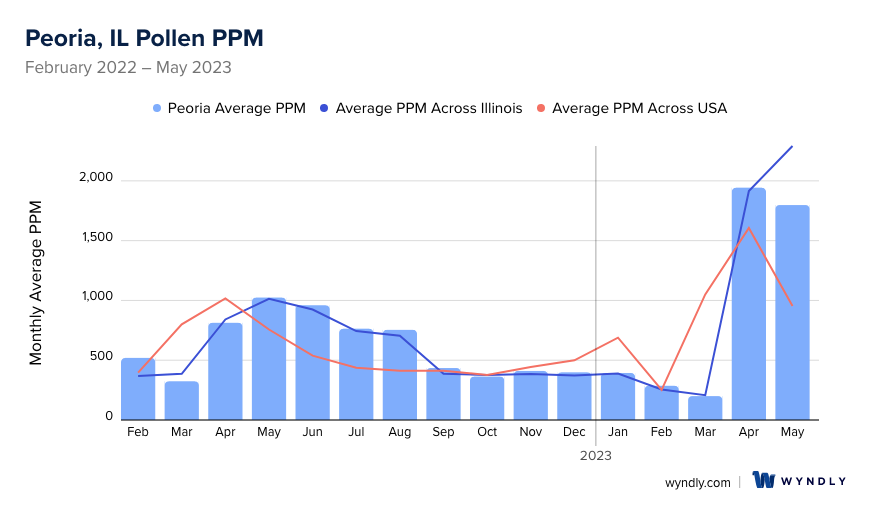
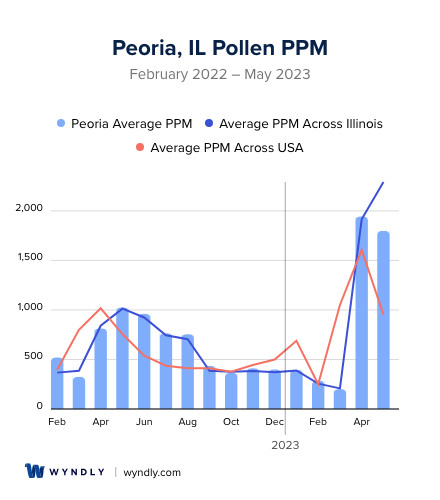
Peoria, IL Pollen and Allergy Breakdown by Month
Grass
When is grass pollen highest in Peoria, IL?
July has the highest grass pollen in Peoria, IL with an average PPM of
When is grass pollen lowest in Peoria, IL?
October has the lowest grass pollen in Peoria, IL with an average PPM of
Tree
When is tree pollen highest in Peoria, IL?
April has the highest tree pollen in Peoria, IL with an average PPM of
When is tree pollen lowest in Peoria, IL?
October has the lowest tree pollen in Peoria, IL with an average PPM of
Weed
When is weed pollen highest in Peoria, IL?
April has the highest weed pollen in Peoria, IL with an average PPM of
When is weed pollen lowest in Peoria, IL?
February has the lowest weed pollen in Peoria, IL with an average PPM of
Peoria, IL Pollen Monthly Breakdown by Pollen Type
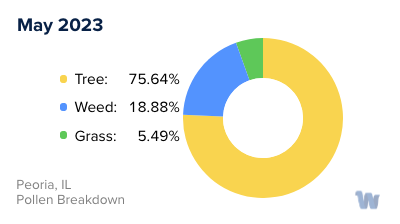
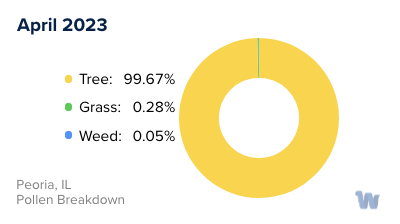
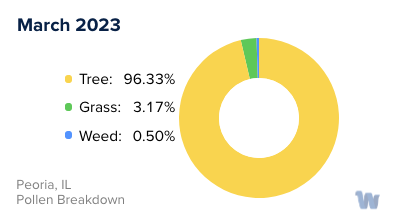
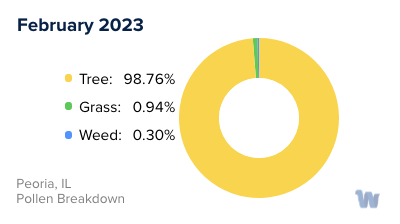
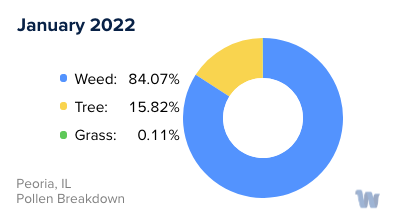
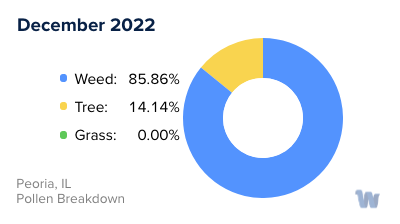
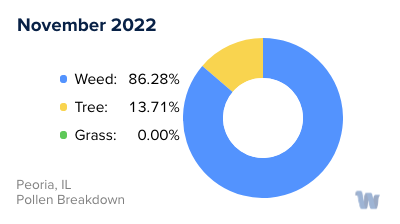
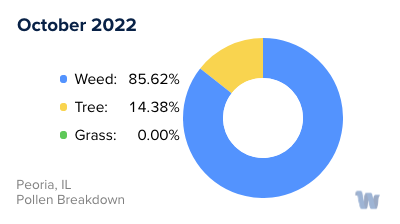
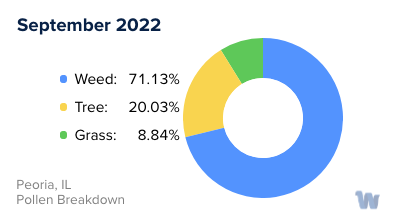
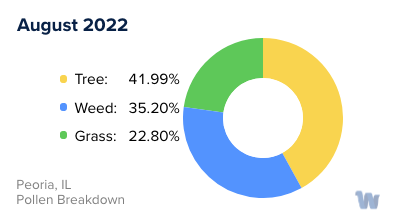
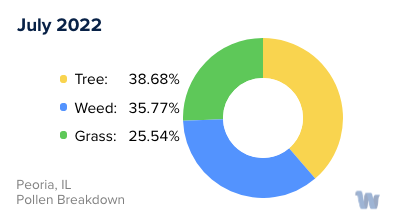
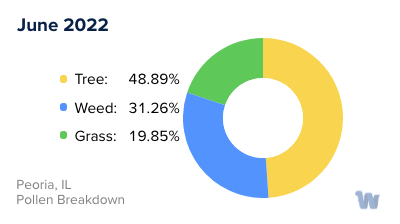
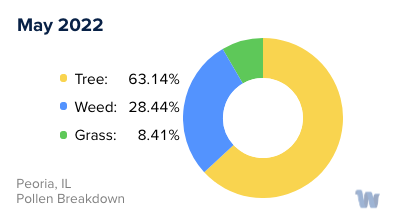
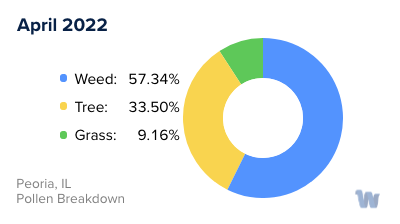
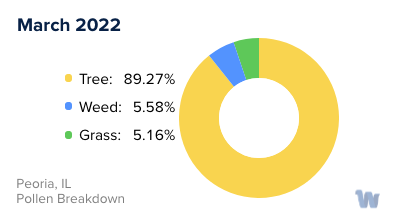
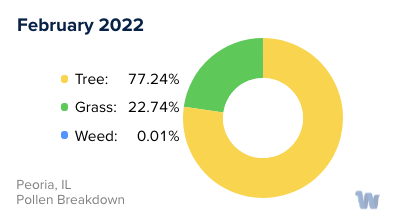
Pollen and Hay Fever in Peoria, IL
Pollen allergies, often referred to as hay fever, are a prevalent issue for many residents of Peoria, Illinois. These allergies are typically triggered by tiny, airborne pollen grains released by trees, grasses, and weeds. The body’s immune system recognizes these pollen grains as foreign invaders, leading to an allergic reaction characterized by sneezing, runny nose, and itchy eyes.
In Peoria, the types of pollen that most commonly cause allergies vary by the season. The city's location in the Midwest exposes it to a diverse range of vegetation, each contributing its own pollen.
In the spring, tree pollen becomes a significant allergen source. The most common trees in Peoria contributing to this are oak, cedar, pine, and maple. As these trees begin to bloom, their pollen saturates the air, causing hay fever symptoms in many individuals.
Moving into the summer, grass pollen takes center stage. In the green expanses of Peoria, the primary culprits are typically ryegrass, bluegrass, and Timothy grass. These grasses release their pollen during the warmest parts of the day, often causing the midday to be particularly challenging for those with allergies.
As fall arrives, weed pollen, especially from ragweed, becomes the primary allergen. Despite its inconspicuous appearance, ragweed can produce a large amount of pollen, with a single plant capable of generating up to a billion grains in a season.
Notably, the timing of these pollen seasons can vary slightly year-to-year based on weather patterns. Warmer, drier conditions often lead to higher pollen counts, as they favor pollen production and can help it travel further distances.
In conclusion, understanding the types of pollen present in different seasons in Peoria can help residents anticipate and manage their pollen allergies. Awareness is key, and being mindful of local pollen levels can help individuals take the necessary precautions to reduce their exposure and maintain their comfort throughout the year.


